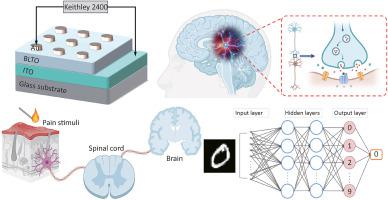当前位置:
X-MOL 学术
›
J. Materiomics
›
论文详情
Our official English website, www.x-mol.net, welcomes your
feedback! (Note: you will need to create a separate account there.)
Artificial synaptic simulating pain-perceptual nociceptor and brain-inspired computing based on Au/Bi3.2La0.8Ti3O12/ITO memristor
Journal of Materiomics ( IF 8.4 ) Pub Date : 2024-04-21 , DOI: 10.1016/j.jmat.2024.03.011 Hao Chen , Zhihao Shen , Wen-Tao Guo , Yan-Ping Jiang , Wenhua Li , Dan Zhang , Zhenhua Tang , Qi-Jun Sun , Xin-Gui Tang
Journal of Materiomics ( IF 8.4 ) Pub Date : 2024-04-21 , DOI: 10.1016/j.jmat.2024.03.011 Hao Chen , Zhihao Shen , Wen-Tao Guo , Yan-Ping Jiang , Wenhua Li , Dan Zhang , Zhenhua Tang , Qi-Jun Sun , Xin-Gui Tang

|
Recently, memristors have garnered widespread attention as neuromorphic devices that can simulate synaptic behavior, holding promise for future commercial applications in neuromorphic computing. In this paper, we present a memristor with an Au/BiLaTiO (BLTO)/ITO structure, demonstrating a switching ratio of nearly 10 over a duration of 10 s. It successfully simulates a range of synaptic behaviors, including long-term potentiation and depression, paired-pulse facilitation, spike-timing-dependent plasticity, spike-rate-dependent plasticity etc. Interestingly, we also employ it to simulate pain threshold, sensitization, and desensitization behaviors of pain-perceptual nociceptor (PPN). Lastly, by introducing memristor differential pairs (1T1R-1T1R), we train a neural network, effectively simplifying the learning process, reducing training time, and achieving a handwriting digit recognition accuracy of up to 97.19 %. Overall, the proposed device holds immense potential in the field of neuromorphic computing, offering possibilities for the next generation of high-performance neuromorphic computing chips.
中文翻译:

基于Au/Bi3.2La0.8Ti3O12/ITO忆阻器的人工突触模拟疼痛感知伤害感受器及类脑计算
最近,忆阻器作为可以模拟突触行为的神经形态器件而受到广泛关注,为未来神经形态计算的商业应用带来了希望。在本文中,我们提出了一种具有 Au/BiLaTiO (BLTO)/ITO 结构的忆阻器,展示了在 10 秒的持续时间内接近 10 的开关比。它成功地模拟了一系列突触行为,包括长期增强和抑制、配对脉冲促进、尖峰时间依赖性可塑性、尖峰速率依赖性可塑性等。有趣的是,我们还用它来模拟疼痛阈值、敏化、和疼痛感知伤害感受器(PPN)的脱敏行为。最后,通过引入忆阻器差分对(1T1R-1T1R)来训练神经网络,有效简化了学习过程,减少了训练时间,手写数字识别准确率高达97.19%。总体而言,所提出的设备在神经形态计算领域具有巨大的潜力,为下一代高性能神经形态计算芯片提供了可能性。
更新日期:2024-04-21
中文翻译:

基于Au/Bi3.2La0.8Ti3O12/ITO忆阻器的人工突触模拟疼痛感知伤害感受器及类脑计算
最近,忆阻器作为可以模拟突触行为的神经形态器件而受到广泛关注,为未来神经形态计算的商业应用带来了希望。在本文中,我们提出了一种具有 Au/BiLaTiO (BLTO)/ITO 结构的忆阻器,展示了在 10 秒的持续时间内接近 10 的开关比。它成功地模拟了一系列突触行为,包括长期增强和抑制、配对脉冲促进、尖峰时间依赖性可塑性、尖峰速率依赖性可塑性等。有趣的是,我们还用它来模拟疼痛阈值、敏化、和疼痛感知伤害感受器(PPN)的脱敏行为。最后,通过引入忆阻器差分对(1T1R-1T1R)来训练神经网络,有效简化了学习过程,减少了训练时间,手写数字识别准确率高达97.19%。总体而言,所提出的设备在神经形态计算领域具有巨大的潜力,为下一代高性能神经形态计算芯片提供了可能性。































 京公网安备 11010802027423号
京公网安备 11010802027423号